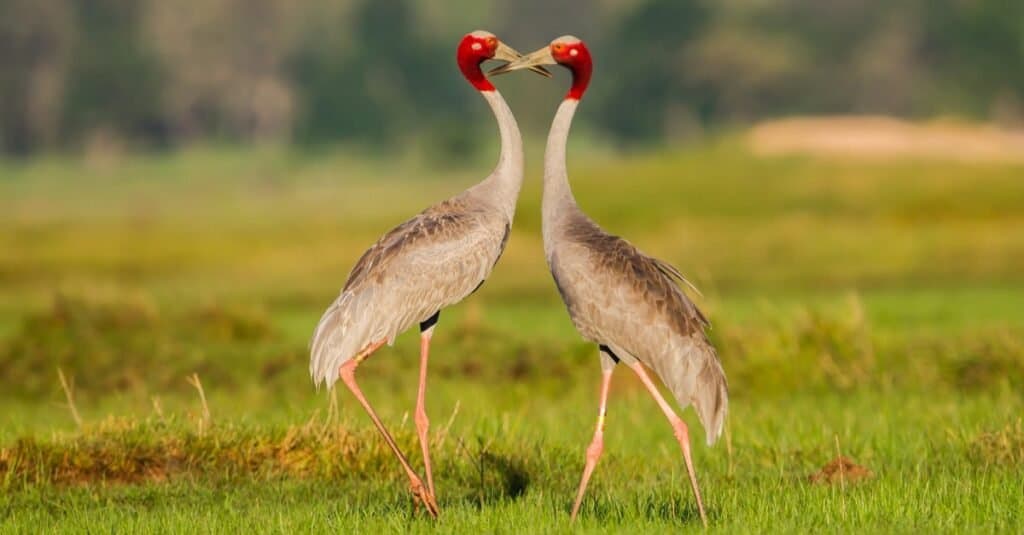Sarus Crane
Antigone antigone
Parents use low calls to tell their chicks to freeze and lie still when danger lurks.
Advertisement
Sarus Crane Scientific Classification
- Kingdom
- Animalia
- Phylum
- Chordata
- Class
- Aves
- Order
- Gruiformes
- Family
- Gruidae
- Genus
- Antigone
- Scientific Name
- Antigone antigone
Read our Complete Guide to Classification of Animals.
Sarus Crane Conservation Status
Sarus Crane Facts
- Prey
- insects, aquatic plants, fish, crustaceans, and seeds
- Name Of Young
- Nestlings, fledglings, chicks
- Group Behavior
- Semi-social
- Fun Fact
- Parents use low calls to tell their chicks to freeze and lie still when danger lurks.
- Estimated Population Size
- 13,000 to 15,000
- Biggest Threat
- habitat loss, ingestion of pesticides
- Most Distinctive Feature
- Long length and wingspan
- Distinctive Feature
- bare, red head
- Wingspan
- 7 to 8 feet
- Incubation Period
- 26 to 35 days
- Age Of Independence
- One year
- Age Of Fledgling
- 3 months
- Habitat
- Marshes, swamps, flooded fields
- Predators
- jackals, jungle crows, dingos, and birds of prey
- Diet
- Carnivore
- Lifestyle
- Diurnal
- Type
- Bird
- Common Name
- sarus crane
- Number Of Species
- 3
- Location
- Asia, Australia
- Nesting Location
- Large platforms in marshes or paddy fields
View all of the Sarus Crane images!
“Sarus cranes symbolize marital fidelity in India and are known for being loyal to their partners during their lifespan.”
Summary
The sarus crane (Antigone antigone) is the tallest flying bird in the world and is native to India, Southeast Asia, and northern Australia. They inhabit wetland environments like marshes and swamps and spend their days foraging for food in pairs. These birds are known for their lifelong mating habits and emotional responses to the death of their partners. Discover the fascinating facts surrounding these majestic birds, including where they live, what they eat, and how they behave.
5 Amazing Sarus Crane Facts
- The sarus crane is the tallest flying bird in the world, measuring almost six feet tall with an eight-foot wingspan.
- While still relatively social, they are the least social in the crane family.
- Some accounts retell of sarus cranes weeping and starving to death if their mate dies.
- Parents use low calls to tell their chicks to freeze and lie still when danger lurks.
- This species is listed as “vulnerable” due to habitat loss, pesticide ingestion, and overhunting.
Where to Find the Sarus Crane
Sarus cranes live in Asia and Australia and in 13 countries, including India, China, Thailand, the Philippines, and Cambodia. It has three distinct populations: Southeastern Asia, the Indian subcontinent, and Northern Australia. These birds are nonmigratory, but they may move locations in correlation with monsoons and droughts. They inhabit wetland environments, such as marshes, swamps, ponds, canals, and flooded fields. Look for them in pairs or small family groups, wading in shallow water, looking for food.
Sarus Crane Nest
Their nests are large platforms constructed in marshes or paddy fields. The pair forms their nest using reeds, straw, grass, and mud to create an island that rises above the water. They do not try to conceal their platforms. Instead, both sexes fiercely defend their area.
Scientific Name
The sarus crane (Antigone antigone) is from the Gruiformes order in the Gruidae family, encompassing the cranes. The genus, Antigone, contains the largest of the crane members. The specific epithet by the same name refers to Greek mythology, where a queen turns into a swan for believing she is more beautiful than the goddess Hera. The sarus crane has four recognized subspecies.
Size, Appearance, & Behavior

A couple of Eastern Sarus Crane (Grus antigone) at Huay Jorrakaemak Reservoir Non-Hunting Area, Thailand. These types of Crane birds are the tallest flying birds in the world.
©kajornyot wildlife photography/Shutterstock.com
The sarus crane is the tallest flying bird in the world. This large crane measures 3.75 to 5.9 feet long and weighs 11 to 26 pounds, with a seven to eight-foot wingspan. Its body and wings are grey, and its head is bare and red, with a greenish-grey bill. Males and females look similar, except the males are slightly bigger on average. Juveniles are distinguishable by their fully-feathered brownish-grey heads.
They are the least social crane species but still form lifelong pair bonds, congregate in small family groups, and join large flocks outside the breeding season. Sarus cranes symbolize marital fidelity in India and are known for being loyal to their partners during their lifespan, even crying and starving to death if they die. These cranes are relatively vocal and make a range of sounds from hissing to purring to screaming. They run moderately fast and cover quite a bit of ground while flying. Although, they tend not to fly long distances.
Migration Pattern and Timing
Sarus cranes are nonmigratory, meaning they live on their breeding grounds year-round. However, they may move short distances in response to monsoons and drought.
Diet
Sarus cranes are omnivores who forage in shallow waters and fields.
What Does the Sarus Crane Eat?
Their diet consists of insects, aquatic plants, fish, crustaceans, and seeds. Occasionally, they will eat water snakes, bird eggs, and turtles. They forage in shallow waters and fields by probing the mud with their long bills. These birds do not feed in large flocks. Instead, they prefer to look for food in scattered pairs.
Predators, Threats, and Conservation Status
The IUCN lists the sarus crane as VU or “vulnerable.” This species has had a vulnerable status since the year 2000 due to a rapid decline in its population size. Its most significant threat is the loss and degradation of its wetland habitat and the ingestion of pesticides. This bird is also vulnerable to hunting and egg collecting for food and trade.
What Eats the Sarus Crane?
The sarus crane does not have any natural predators except for humans. But its eggs and young fall victim to jackals, jungle crows, dingos, and birds of prey. Their large size makes them intimidating to potential predators, and their nests are typically robbed when they leave them unattended. Parents will use low calls, telling their chicks to freeze and lie still when danger lurks.
Reproduction, Young, and Molting
Sarus cranes are monogamous and mate for life. However, they may engage in “divorce” and find new partners. Their breeding season is from June to September (during the rainy season), and courtship rituals include loud calls, posturing, and dancing. Females lay one to two eggs, and both sexes take turns incubating for 26 to 35 days. The chicks can feed themselves after a few days and fly around three months old. They don’t typically leave their parent’s territory until the next breeding season. The sarus crane becomes sexually mature around five years and has an average lifespan of 15.6 years. However, they can live up to 42 years.
Population
The global sarus crane population is estimated to number 13,000 to 15,000 mature individuals. They are not experiencing any extreme fluctuations or fragmentations in their numbers. Their population has decreased due to habitat loss, pesticides, and overhunting.
Related Animals:
View all 293 animals that start with SSarus Crane FAQs (Frequently Asked Questions)
Can a sarus crane fly?
Sarus cranes are strong graceful fliers and can cover quite a bit of ground. However, they tend not to fly long distances.
Why is the sarus crane threatened?
Its most significant threat is the loss and degradation of its wetland habitat and the ingestion of pesticides. This bird is also vulnerable to hunting and egg collecting for food and trade.
How tall is a sarus crane?
The sarus crane is the tallest flying bird in the world. This large crane measures 3.75 to 5.9 feet long and weighs 11 to 26 pounds, with a seven to eight-foot wingspan.
Where does the sarus crane live?
It has three distinct populations: Southeastern Asia, the Indian subcontinent, and Northern Australia.
Are sarus cranes social?
They are the least social crane species but still form lifelong pair bonds, congregate in small family groups, and join large flocks outside the breeding season.
What are sarus cranes known for?
They are known for being loyal to their partners during their lifespan, even crying and starving to death if they die.
What do sarus cranes eat?
Their diet consists of insects, aquatic plants, fish, crustaceans, and seeds. Occasionally, they will eat water snakes, bird eggs, and turtles.
Thank you for reading! Have some feedback for us? Contact the AZ Animals editorial team.
Sources
- The Red List / Bird Life International, Available here: https://www.iucnredlist.org/species/22692064/93335364

















